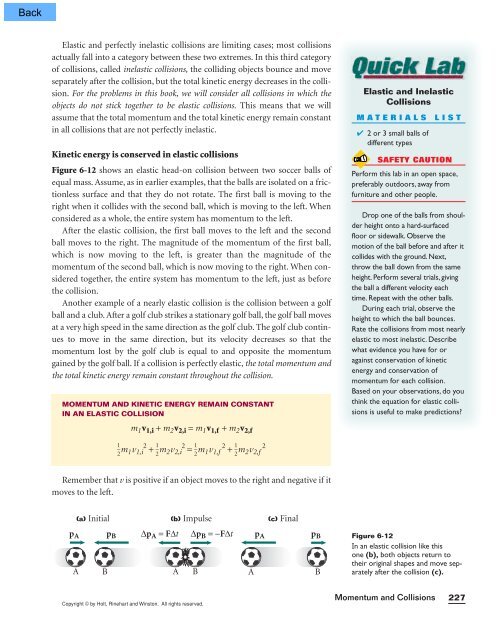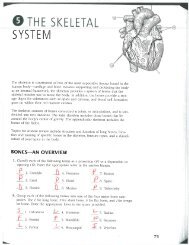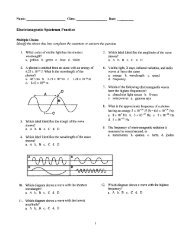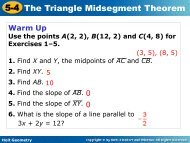Create successful ePaper yourself
Turn your PDF publications into a flip-book with our unique Google optimized e-Paper software.
Elastic and perfectly inelastic collisions are limiting cases; most collisionsactually fall into a category between these two extremes. In this third categoryof collisions, called inelastic collisions, the colliding objects bounce and moveseparately after the collision, but the total kinetic energy decreases in the collision.For the problems in this book, we will consider all collisions in which theobjects do not stick together to be elastic collisions. This means that we willassume that the total momentum and the total kinetic energy remain constantin all collisions that are not perfectly inelastic.Kinetic energy is conserved in elastic collisionsFigure 6-12 shows an elastic head-on collision between two soccer balls ofequal mass. Assume, as in earlier examples, that the balls are isolated on a frictionlesssurface and that they do not rotate. The first ball is moving to theright when it collides with the second ball, which is moving to the left. Whenconsidered as a whole, the entire system has momentum to the left.After the elastic collision, the first ball moves to the left and the secondball moves to the right. The magnitude of the momentum of the first ball,which is now moving to the left, is greater than the magnitude of themomentum of the second ball, which is now moving to the right. When consideredtogether, the entire system has momentum to the left, just as beforethe collision.Another example of a nearly elastic collision is the collision between a golfball and a club. After a golf club strikes a stationary golf ball, the golf ball movesat a very high speed in the same direction as the golf club. The golf club continuesto move in the same direction, but its velocity decreases so that themomentum lost by the golf club is equal to and opposite the momentumgained by the golf ball. If a collision is perfectly elastic, the total momentum andthe total kinetic energy remain constant throughout the collision.MOMENTUM AND KINETIC ENERGY REMAIN CONSTANTIN AN ELASTIC COLLISIONElastic and InelasticCollisionsMATERIALS LIST✔ 2 or 3 small balls ofdifferent typesSAFETY CAUTIONPerform this lab in an open space,preferably outdoors, away fromfurniture and other people.Drop one of the balls from shoulderheight onto a hard-surfacedfloor or sidewalk. Observe themotion of the ball before and after itcollides with the ground. Next,throw the ball down from the sameheight. Perform several trials, givingthe ball a different velocity eachtime. Repeat with the other balls.During each trial, observe theheight to which the ball bounces.Rate the collisions from most nearlyelastic to most inelastic. Describewhat evidence you have for oragainst conservation of kineticenergy and conservation ofmomentum for each collision.Based on your observations, do youthink the equation for elastic collisionsis useful to make predictions?m 1 v 1,i + m 2 v 2,i = m 1 v 1,f + m 2 v 2,f1⎯2 ⎯ 2m 1 v 1,i + ⎯ 1 2 ⎯ 2m 2 v 2,i = ⎯ 1 2 ⎯ 2m 1 v 1,f + ⎯ 1 2 ⎯ 2m 2 v 2,fRemember that v is positive if an object moves to the right and negative if itmoves to the left.(a) Initial(b) Impulse(c) Finalp A p B ∆p A = F ∆t∆p B = −F t p Ap B Figure 6-12In an elastic collision like thisone (b), both objects return totheir original shapes and move separatelyA BA BABafter the collision (c).∆Copyright © by Holt, Rinehart and Winston. All rights reserved.Momentum and Collisions227
















